Logistics and Supply Chain Management: Starbucks Case Study Analysis
VerifiedAdded on 2022/10/31
|8
|2034
|256
Case Study
AI Summary
This case study examines Starbucks Corporation's implementation of a centralized supply chain management system. The study explores the reasons behind Starbucks' adoption of this practice, including challenges related to climate change, fluctuating commodity prices, rising labor costs, and the need to maintain strong relationships with suppliers and partners. The analysis details how centralization has improved Starbucks' supply chain performance, such as maintaining sustainable sourcing, price stability, and vertical integration. The case study also outlines the benefits of centralization, including better operational control, efficient inventory management, reduced distribution costs, and enhanced product standardization. Furthermore, the study discusses which other companies could benefit from a centralized system, while also identifying those for which it may not be suitable. The case study concludes by considering the future of centralized systems in the context of Starbucks and its industry, emphasizing the need for flexibility and adaptation to local market preferences and competition.
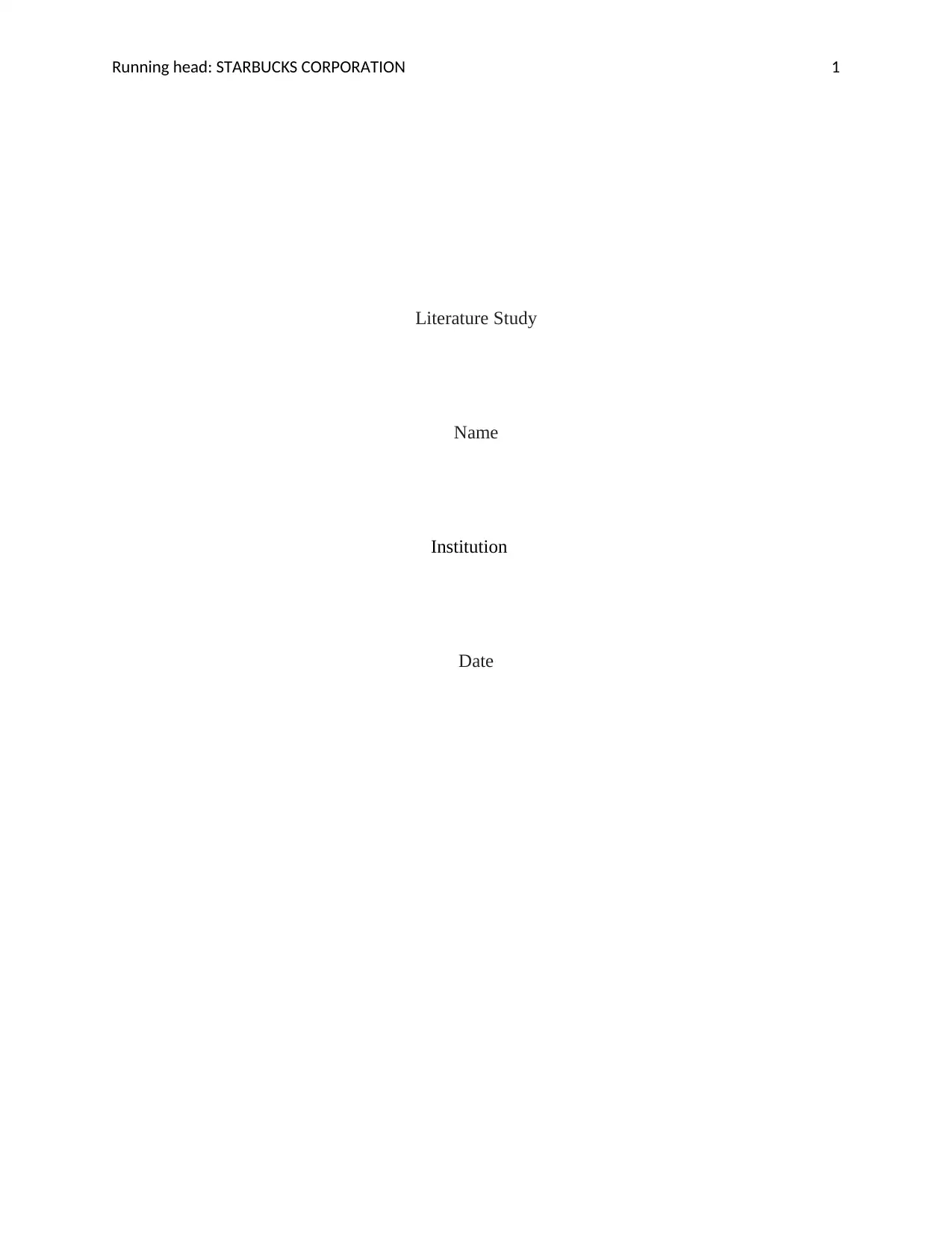
Running head: STARBUCKS CORPORATION 1
Literature Study
Name
Institution
Date
Literature Study
Name
Institution
Date
Paraphrase This Document
Need a fresh take? Get an instant paraphrase of this document with our AI Paraphraser
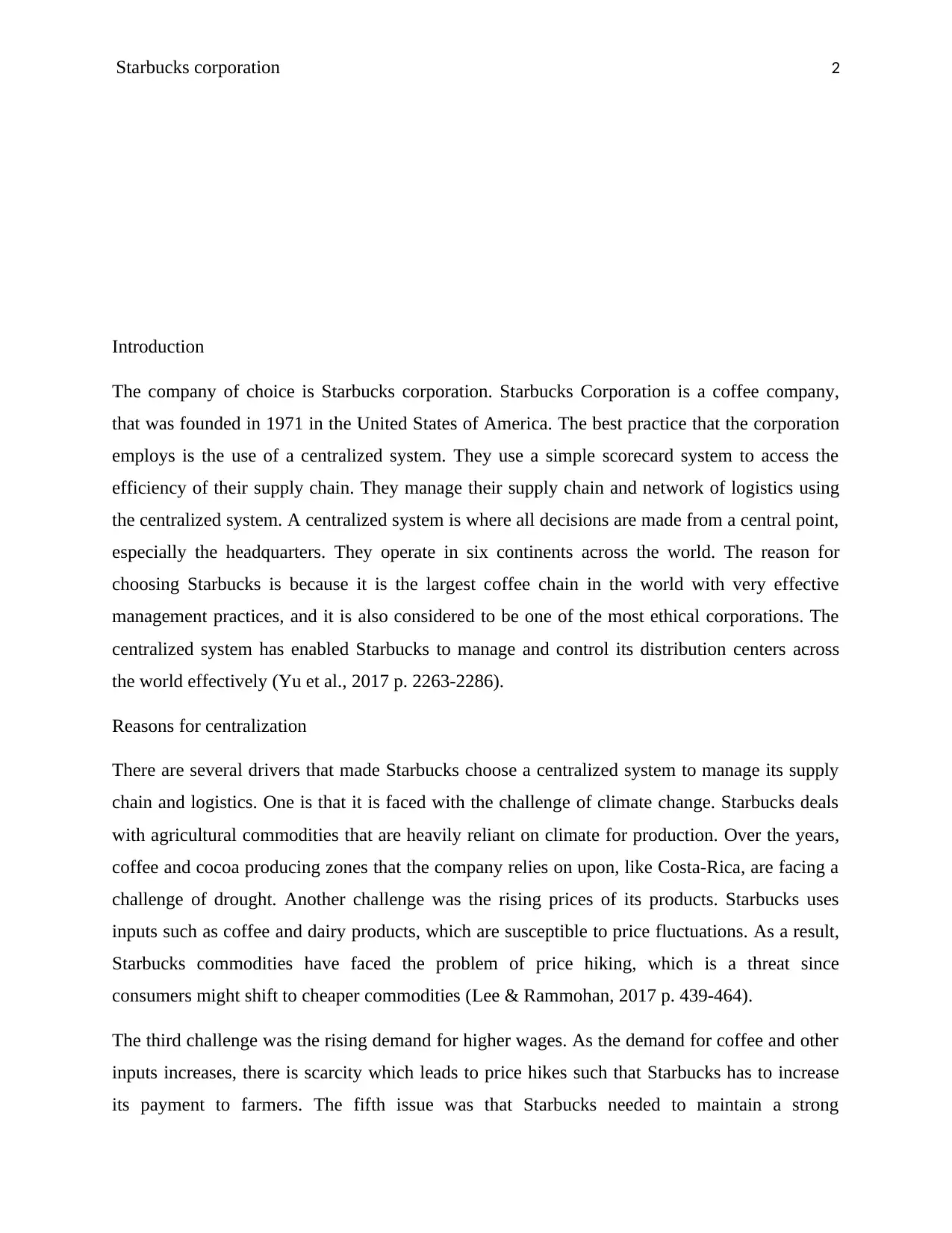
Starbucks corporation 2
Introduction
The company of choice is Starbucks corporation. Starbucks Corporation is a coffee company,
that was founded in 1971 in the United States of America. The best practice that the corporation
employs is the use of a centralized system. They use a simple scorecard system to access the
efficiency of their supply chain. They manage their supply chain and network of logistics using
the centralized system. A centralized system is where all decisions are made from a central point,
especially the headquarters. They operate in six continents across the world. The reason for
choosing Starbucks is because it is the largest coffee chain in the world with very effective
management practices, and it is also considered to be one of the most ethical corporations. The
centralized system has enabled Starbucks to manage and control its distribution centers across
the world effectively (Yu et al., 2017 p. 2263-2286).
Reasons for centralization
There are several drivers that made Starbucks choose a centralized system to manage its supply
chain and logistics. One is that it is faced with the challenge of climate change. Starbucks deals
with agricultural commodities that are heavily reliant on climate for production. Over the years,
coffee and cocoa producing zones that the company relies on upon, like Costa-Rica, are facing a
challenge of drought. Another challenge was the rising prices of its products. Starbucks uses
inputs such as coffee and dairy products, which are susceptible to price fluctuations. As a result,
Starbucks commodities have faced the problem of price hiking, which is a threat since
consumers might shift to cheaper commodities (Lee & Rammohan, 2017 p. 439-464).
The third challenge was the rising demand for higher wages. As the demand for coffee and other
inputs increases, there is scarcity which leads to price hikes such that Starbucks has to increase
its payment to farmers. The fifth issue was that Starbucks needed to maintain a strong
Introduction
The company of choice is Starbucks corporation. Starbucks Corporation is a coffee company,
that was founded in 1971 in the United States of America. The best practice that the corporation
employs is the use of a centralized system. They use a simple scorecard system to access the
efficiency of their supply chain. They manage their supply chain and network of logistics using
the centralized system. A centralized system is where all decisions are made from a central point,
especially the headquarters. They operate in six continents across the world. The reason for
choosing Starbucks is because it is the largest coffee chain in the world with very effective
management practices, and it is also considered to be one of the most ethical corporations. The
centralized system has enabled Starbucks to manage and control its distribution centers across
the world effectively (Yu et al., 2017 p. 2263-2286).
Reasons for centralization
There are several drivers that made Starbucks choose a centralized system to manage its supply
chain and logistics. One is that it is faced with the challenge of climate change. Starbucks deals
with agricultural commodities that are heavily reliant on climate for production. Over the years,
coffee and cocoa producing zones that the company relies on upon, like Costa-Rica, are facing a
challenge of drought. Another challenge was the rising prices of its products. Starbucks uses
inputs such as coffee and dairy products, which are susceptible to price fluctuations. As a result,
Starbucks commodities have faced the problem of price hiking, which is a threat since
consumers might shift to cheaper commodities (Lee & Rammohan, 2017 p. 439-464).
The third challenge was the rising demand for higher wages. As the demand for coffee and other
inputs increases, there is scarcity which leads to price hikes such that Starbucks has to increase
its payment to farmers. The fifth issue was that Starbucks needed to maintain a strong
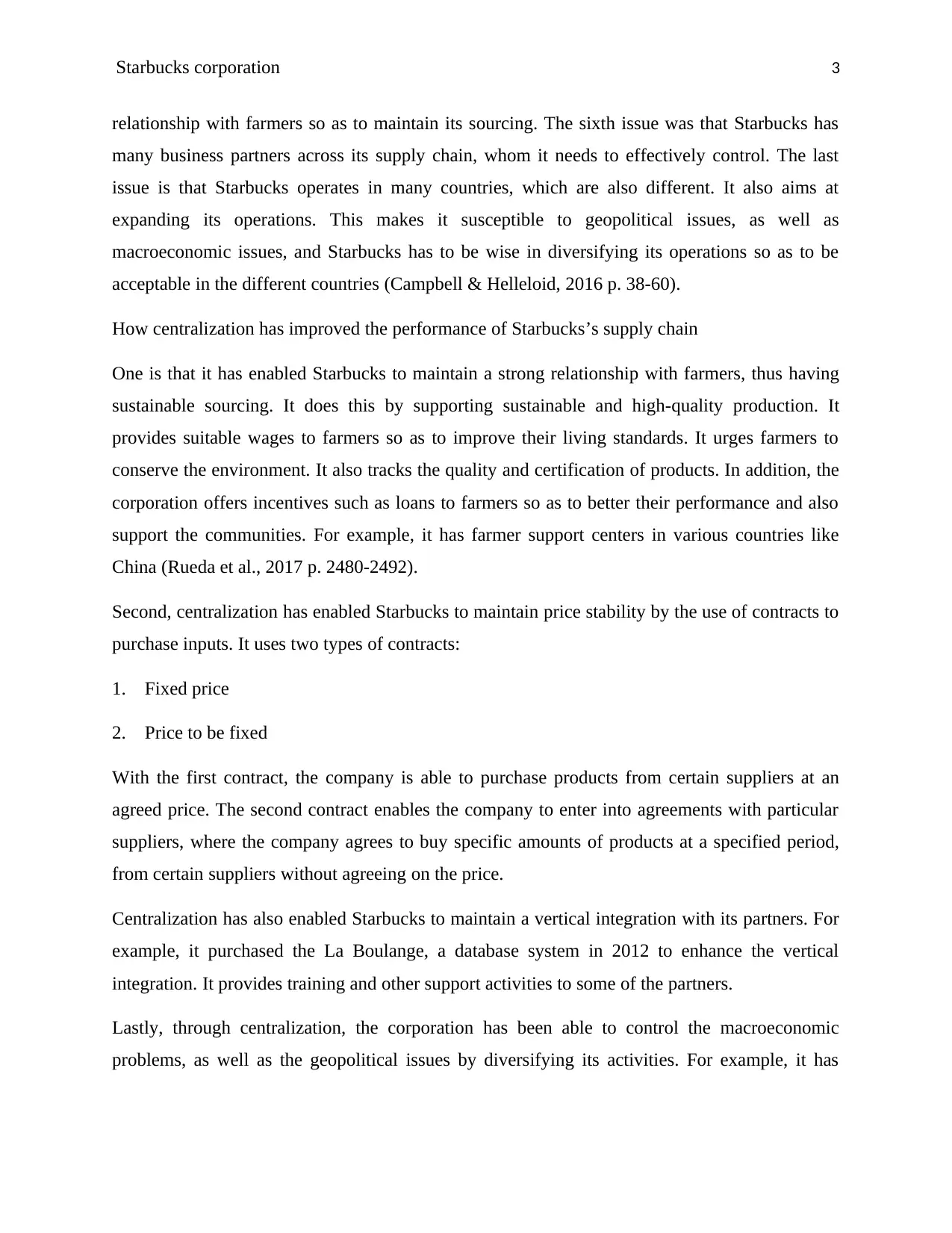
Starbucks corporation 3
relationship with farmers so as to maintain its sourcing. The sixth issue was that Starbucks has
many business partners across its supply chain, whom it needs to effectively control. The last
issue is that Starbucks operates in many countries, which are also different. It also aims at
expanding its operations. This makes it susceptible to geopolitical issues, as well as
macroeconomic issues, and Starbucks has to be wise in diversifying its operations so as to be
acceptable in the different countries (Campbell & Helleloid, 2016 p. 38-60).
How centralization has improved the performance of Starbucks’s supply chain
One is that it has enabled Starbucks to maintain a strong relationship with farmers, thus having
sustainable sourcing. It does this by supporting sustainable and high-quality production. It
provides suitable wages to farmers so as to improve their living standards. It urges farmers to
conserve the environment. It also tracks the quality and certification of products. In addition, the
corporation offers incentives such as loans to farmers so as to better their performance and also
support the communities. For example, it has farmer support centers in various countries like
China (Rueda et al., 2017 p. 2480-2492).
Second, centralization has enabled Starbucks to maintain price stability by the use of contracts to
purchase inputs. It uses two types of contracts:
1. Fixed price
2. Price to be fixed
With the first contract, the company is able to purchase products from certain suppliers at an
agreed price. The second contract enables the company to enter into agreements with particular
suppliers, where the company agrees to buy specific amounts of products at a specified period,
from certain suppliers without agreeing on the price.
Centralization has also enabled Starbucks to maintain a vertical integration with its partners. For
example, it purchased the La Boulange, a database system in 2012 to enhance the vertical
integration. It provides training and other support activities to some of the partners.
Lastly, through centralization, the corporation has been able to control the macroeconomic
problems, as well as the geopolitical issues by diversifying its activities. For example, it has
relationship with farmers so as to maintain its sourcing. The sixth issue was that Starbucks has
many business partners across its supply chain, whom it needs to effectively control. The last
issue is that Starbucks operates in many countries, which are also different. It also aims at
expanding its operations. This makes it susceptible to geopolitical issues, as well as
macroeconomic issues, and Starbucks has to be wise in diversifying its operations so as to be
acceptable in the different countries (Campbell & Helleloid, 2016 p. 38-60).
How centralization has improved the performance of Starbucks’s supply chain
One is that it has enabled Starbucks to maintain a strong relationship with farmers, thus having
sustainable sourcing. It does this by supporting sustainable and high-quality production. It
provides suitable wages to farmers so as to improve their living standards. It urges farmers to
conserve the environment. It also tracks the quality and certification of products. In addition, the
corporation offers incentives such as loans to farmers so as to better their performance and also
support the communities. For example, it has farmer support centers in various countries like
China (Rueda et al., 2017 p. 2480-2492).
Second, centralization has enabled Starbucks to maintain price stability by the use of contracts to
purchase inputs. It uses two types of contracts:
1. Fixed price
2. Price to be fixed
With the first contract, the company is able to purchase products from certain suppliers at an
agreed price. The second contract enables the company to enter into agreements with particular
suppliers, where the company agrees to buy specific amounts of products at a specified period,
from certain suppliers without agreeing on the price.
Centralization has also enabled Starbucks to maintain a vertical integration with its partners. For
example, it purchased the La Boulange, a database system in 2012 to enhance the vertical
integration. It provides training and other support activities to some of the partners.
Lastly, through centralization, the corporation has been able to control the macroeconomic
problems, as well as the geopolitical issues by diversifying its activities. For example, it has
⊘ This is a preview!⊘
Do you want full access?
Subscribe today to unlock all pages.

Trusted by 1+ million students worldwide
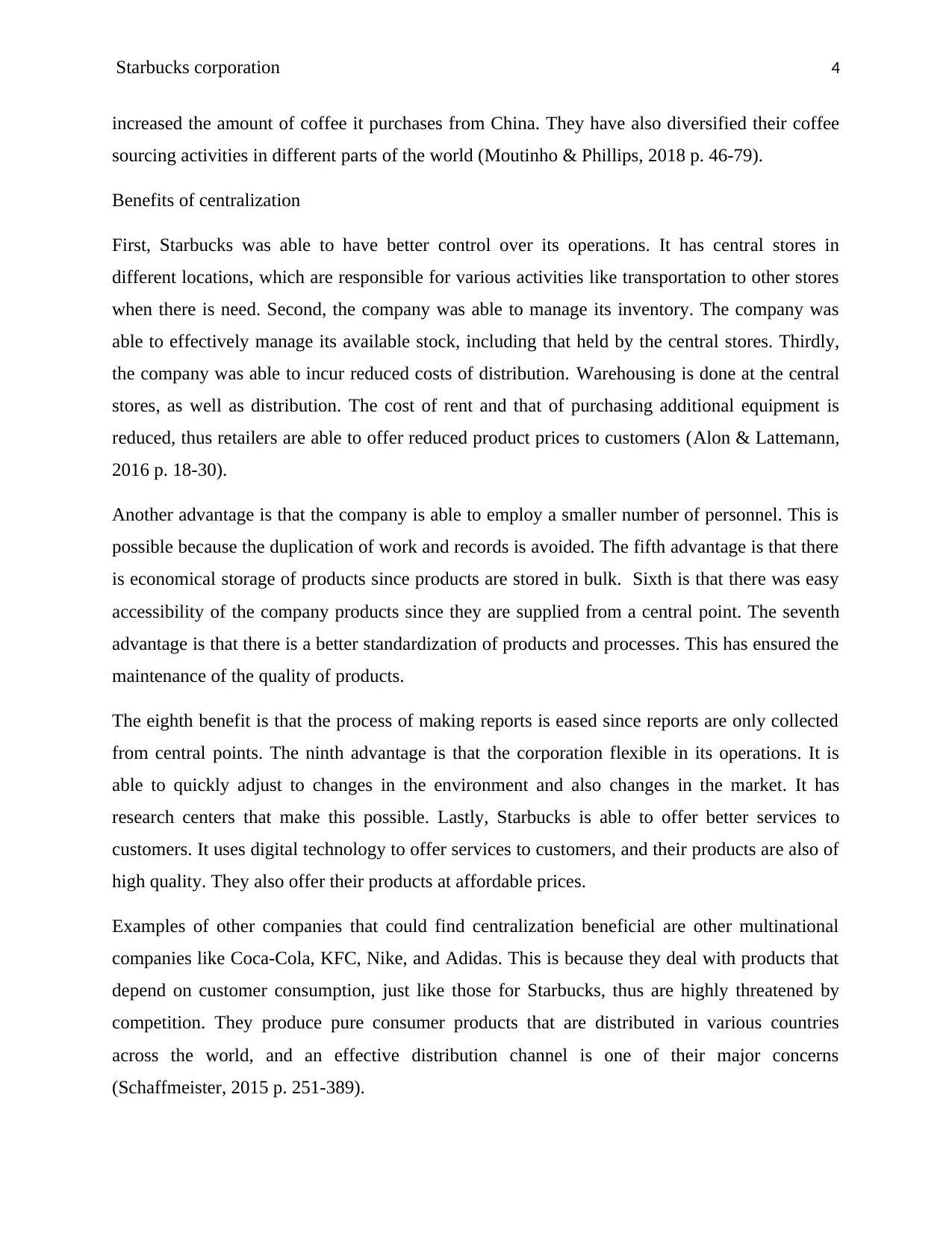
Starbucks corporation 4
increased the amount of coffee it purchases from China. They have also diversified their coffee
sourcing activities in different parts of the world (Moutinho & Phillips, 2018 p. 46-79).
Benefits of centralization
First, Starbucks was able to have better control over its operations. It has central stores in
different locations, which are responsible for various activities like transportation to other stores
when there is need. Second, the company was able to manage its inventory. The company was
able to effectively manage its available stock, including that held by the central stores. Thirdly,
the company was able to incur reduced costs of distribution. Warehousing is done at the central
stores, as well as distribution. The cost of rent and that of purchasing additional equipment is
reduced, thus retailers are able to offer reduced product prices to customers (Alon & Lattemann,
2016 p. 18-30).
Another advantage is that the company is able to employ a smaller number of personnel. This is
possible because the duplication of work and records is avoided. The fifth advantage is that there
is economical storage of products since products are stored in bulk. Sixth is that there was easy
accessibility of the company products since they are supplied from a central point. The seventh
advantage is that there is a better standardization of products and processes. This has ensured the
maintenance of the quality of products.
The eighth benefit is that the process of making reports is eased since reports are only collected
from central points. The ninth advantage is that the corporation flexible in its operations. It is
able to quickly adjust to changes in the environment and also changes in the market. It has
research centers that make this possible. Lastly, Starbucks is able to offer better services to
customers. It uses digital technology to offer services to customers, and their products are also of
high quality. They also offer their products at affordable prices.
Examples of other companies that could find centralization beneficial are other multinational
companies like Coca-Cola, KFC, Nike, and Adidas. This is because they deal with products that
depend on customer consumption, just like those for Starbucks, thus are highly threatened by
competition. They produce pure consumer products that are distributed in various countries
across the world, and an effective distribution channel is one of their major concerns
(Schaffmeister, 2015 p. 251-389).
increased the amount of coffee it purchases from China. They have also diversified their coffee
sourcing activities in different parts of the world (Moutinho & Phillips, 2018 p. 46-79).
Benefits of centralization
First, Starbucks was able to have better control over its operations. It has central stores in
different locations, which are responsible for various activities like transportation to other stores
when there is need. Second, the company was able to manage its inventory. The company was
able to effectively manage its available stock, including that held by the central stores. Thirdly,
the company was able to incur reduced costs of distribution. Warehousing is done at the central
stores, as well as distribution. The cost of rent and that of purchasing additional equipment is
reduced, thus retailers are able to offer reduced product prices to customers (Alon & Lattemann,
2016 p. 18-30).
Another advantage is that the company is able to employ a smaller number of personnel. This is
possible because the duplication of work and records is avoided. The fifth advantage is that there
is economical storage of products since products are stored in bulk. Sixth is that there was easy
accessibility of the company products since they are supplied from a central point. The seventh
advantage is that there is a better standardization of products and processes. This has ensured the
maintenance of the quality of products.
The eighth benefit is that the process of making reports is eased since reports are only collected
from central points. The ninth advantage is that the corporation flexible in its operations. It is
able to quickly adjust to changes in the environment and also changes in the market. It has
research centers that make this possible. Lastly, Starbucks is able to offer better services to
customers. It uses digital technology to offer services to customers, and their products are also of
high quality. They also offer their products at affordable prices.
Examples of other companies that could find centralization beneficial are other multinational
companies like Coca-Cola, KFC, Nike, and Adidas. This is because they deal with products that
depend on customer consumption, just like those for Starbucks, thus are highly threatened by
competition. They produce pure consumer products that are distributed in various countries
across the world, and an effective distribution channel is one of their major concerns
(Schaffmeister, 2015 p. 251-389).
Paraphrase This Document
Need a fresh take? Get an instant paraphrase of this document with our AI Paraphraser
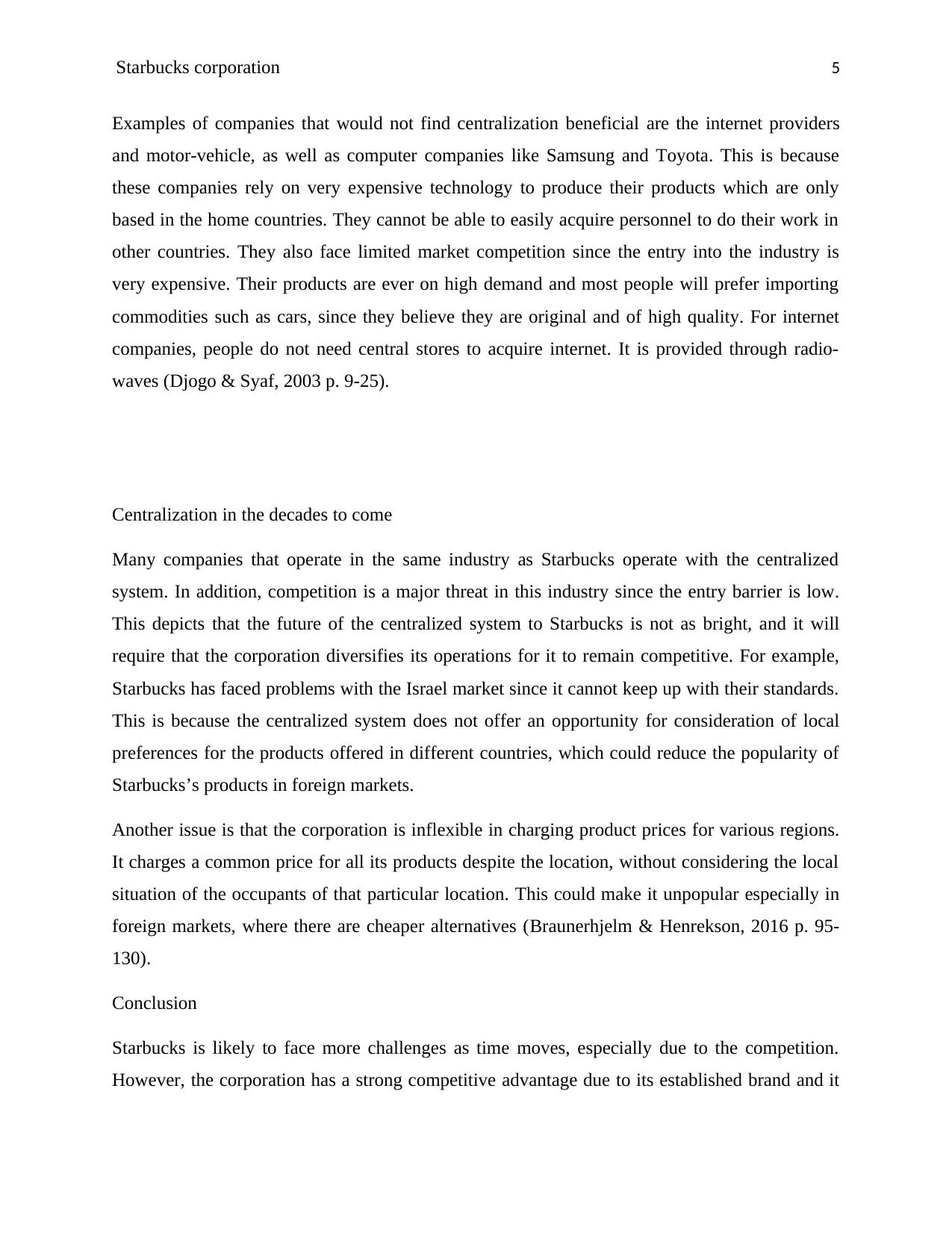
Starbucks corporation 5
Examples of companies that would not find centralization beneficial are the internet providers
and motor-vehicle, as well as computer companies like Samsung and Toyota. This is because
these companies rely on very expensive technology to produce their products which are only
based in the home countries. They cannot be able to easily acquire personnel to do their work in
other countries. They also face limited market competition since the entry into the industry is
very expensive. Their products are ever on high demand and most people will prefer importing
commodities such as cars, since they believe they are original and of high quality. For internet
companies, people do not need central stores to acquire internet. It is provided through radio-
waves (Djogo & Syaf, 2003 p. 9-25).
Centralization in the decades to come
Many companies that operate in the same industry as Starbucks operate with the centralized
system. In addition, competition is a major threat in this industry since the entry barrier is low.
This depicts that the future of the centralized system to Starbucks is not as bright, and it will
require that the corporation diversifies its operations for it to remain competitive. For example,
Starbucks has faced problems with the Israel market since it cannot keep up with their standards.
This is because the centralized system does not offer an opportunity for consideration of local
preferences for the products offered in different countries, which could reduce the popularity of
Starbucks’s products in foreign markets.
Another issue is that the corporation is inflexible in charging product prices for various regions.
It charges a common price for all its products despite the location, without considering the local
situation of the occupants of that particular location. This could make it unpopular especially in
foreign markets, where there are cheaper alternatives (Braunerhjelm & Henrekson, 2016 p. 95-
130).
Conclusion
Starbucks is likely to face more challenges as time moves, especially due to the competition.
However, the corporation has a strong competitive advantage due to its established brand and it
Examples of companies that would not find centralization beneficial are the internet providers
and motor-vehicle, as well as computer companies like Samsung and Toyota. This is because
these companies rely on very expensive technology to produce their products which are only
based in the home countries. They cannot be able to easily acquire personnel to do their work in
other countries. They also face limited market competition since the entry into the industry is
very expensive. Their products are ever on high demand and most people will prefer importing
commodities such as cars, since they believe they are original and of high quality. For internet
companies, people do not need central stores to acquire internet. It is provided through radio-
waves (Djogo & Syaf, 2003 p. 9-25).
Centralization in the decades to come
Many companies that operate in the same industry as Starbucks operate with the centralized
system. In addition, competition is a major threat in this industry since the entry barrier is low.
This depicts that the future of the centralized system to Starbucks is not as bright, and it will
require that the corporation diversifies its operations for it to remain competitive. For example,
Starbucks has faced problems with the Israel market since it cannot keep up with their standards.
This is because the centralized system does not offer an opportunity for consideration of local
preferences for the products offered in different countries, which could reduce the popularity of
Starbucks’s products in foreign markets.
Another issue is that the corporation is inflexible in charging product prices for various regions.
It charges a common price for all its products despite the location, without considering the local
situation of the occupants of that particular location. This could make it unpopular especially in
foreign markets, where there are cheaper alternatives (Braunerhjelm & Henrekson, 2016 p. 95-
130).
Conclusion
Starbucks is likely to face more challenges as time moves, especially due to the competition.
However, the corporation has a strong competitive advantage due to its established brand and it
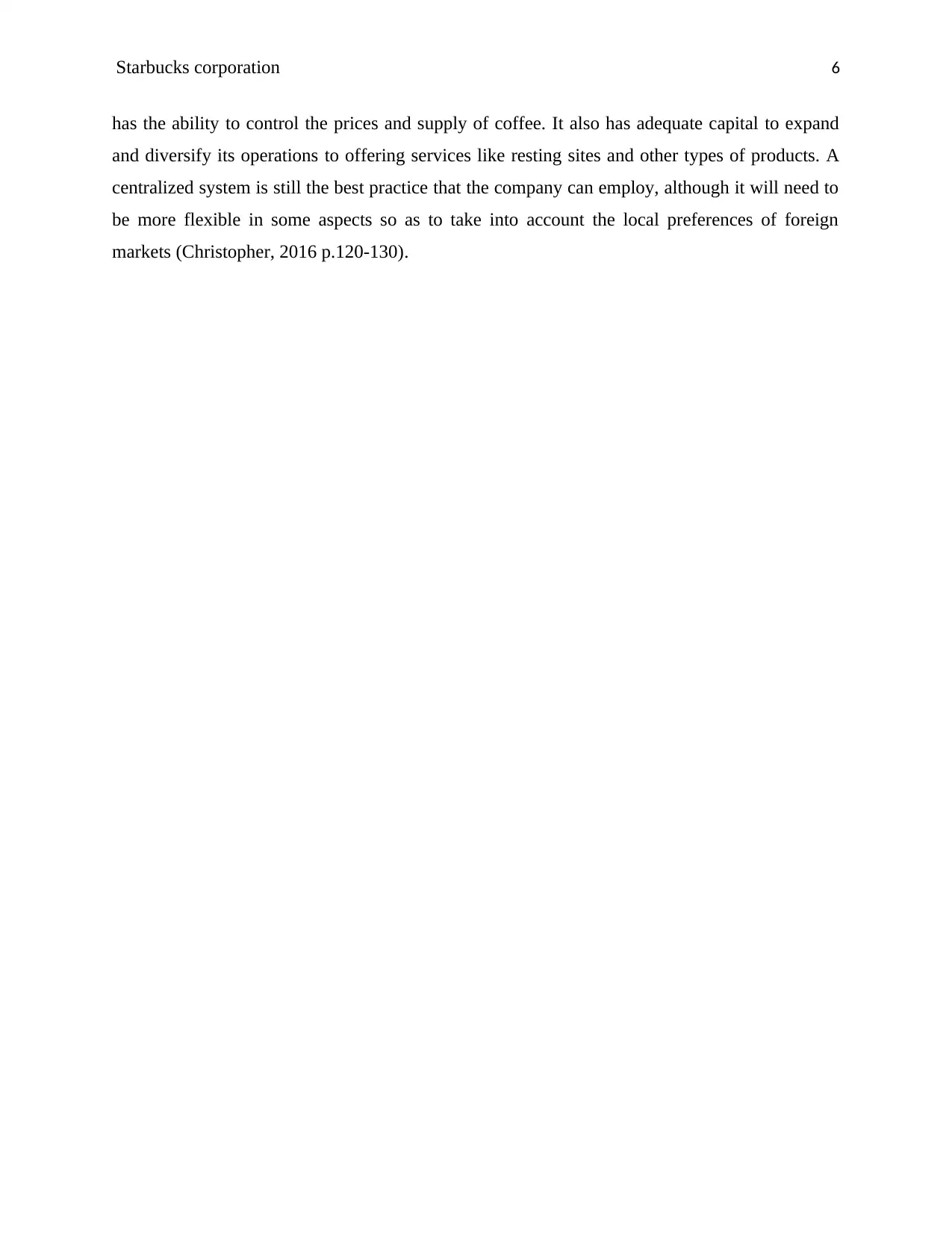
Starbucks corporation 6
has the ability to control the prices and supply of coffee. It also has adequate capital to expand
and diversify its operations to offering services like resting sites and other types of products. A
centralized system is still the best practice that the company can employ, although it will need to
be more flexible in some aspects so as to take into account the local preferences of foreign
markets (Christopher, 2016 p.120-130).
has the ability to control the prices and supply of coffee. It also has adequate capital to expand
and diversify its operations to offering services like resting sites and other types of products. A
centralized system is still the best practice that the company can employ, although it will need to
be more flexible in some aspects so as to take into account the local preferences of foreign
markets (Christopher, 2016 p.120-130).
⊘ This is a preview!⊘
Do you want full access?
Subscribe today to unlock all pages.

Trusted by 1+ million students worldwide
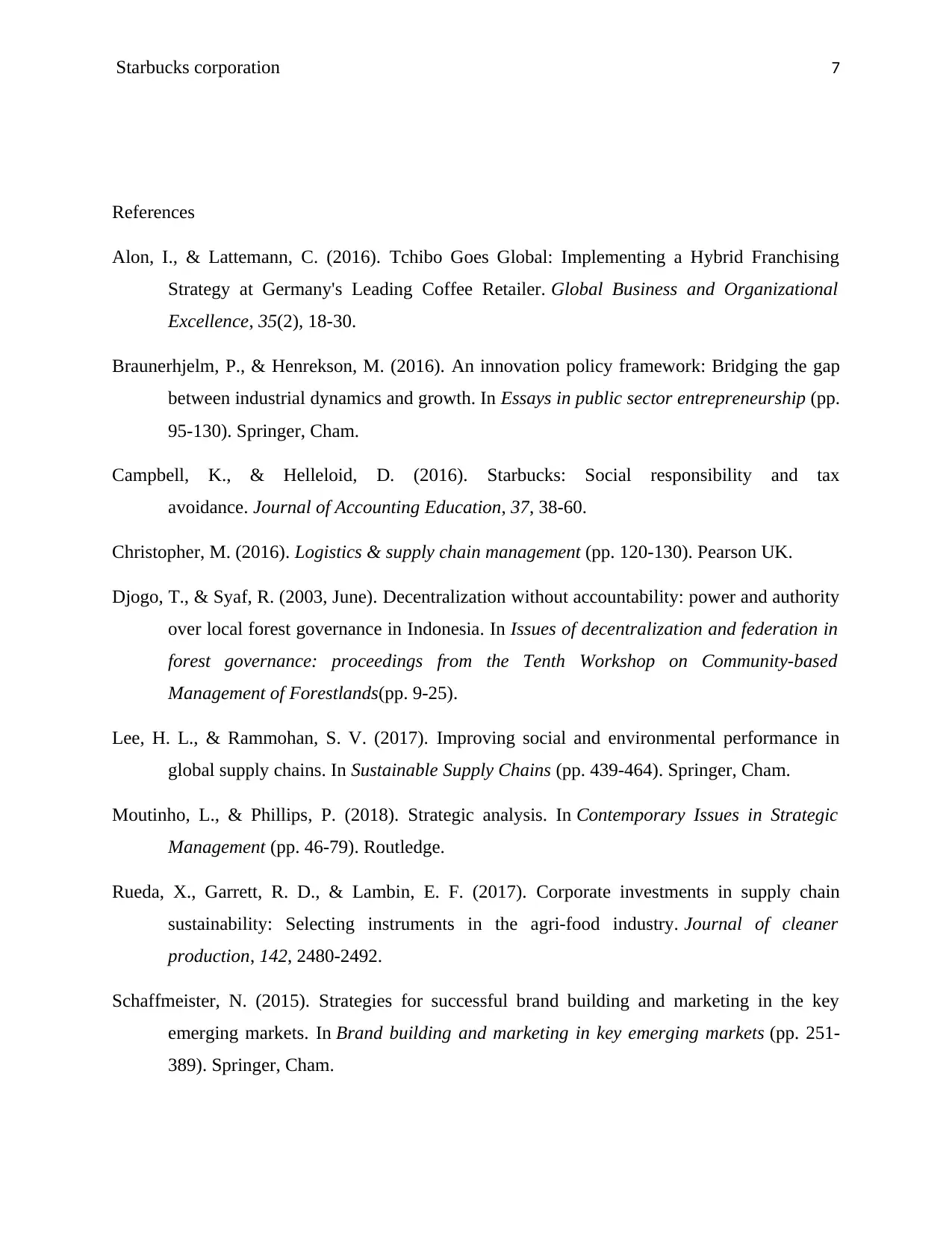
Starbucks corporation 7
References
Alon, I., & Lattemann, C. (2016). Tchibo Goes Global: Implementing a Hybrid Franchising
Strategy at Germany's Leading Coffee Retailer. Global Business and Organizational
Excellence, 35(2), 18-30.
Braunerhjelm, P., & Henrekson, M. (2016). An innovation policy framework: Bridging the gap
between industrial dynamics and growth. In Essays in public sector entrepreneurship (pp.
95-130). Springer, Cham.
Campbell, K., & Helleloid, D. (2016). Starbucks: Social responsibility and tax
avoidance. Journal of Accounting Education, 37, 38-60.
Christopher, M. (2016). Logistics & supply chain management (pp. 120-130). Pearson UK.
Djogo, T., & Syaf, R. (2003, June). Decentralization without accountability: power and authority
over local forest governance in Indonesia. In Issues of decentralization and federation in
forest governance: proceedings from the Tenth Workshop on Community-based
Management of Forestlands(pp. 9-25).
Lee, H. L., & Rammohan, S. V. (2017). Improving social and environmental performance in
global supply chains. In Sustainable Supply Chains (pp. 439-464). Springer, Cham.
Moutinho, L., & Phillips, P. (2018). Strategic analysis. In Contemporary Issues in Strategic
Management (pp. 46-79). Routledge.
Rueda, X., Garrett, R. D., & Lambin, E. F. (2017). Corporate investments in supply chain
sustainability: Selecting instruments in the agri-food industry. Journal of cleaner
production, 142, 2480-2492.
Schaffmeister, N. (2015). Strategies for successful brand building and marketing in the key
emerging markets. In Brand building and marketing in key emerging markets (pp. 251-
389). Springer, Cham.
References
Alon, I., & Lattemann, C. (2016). Tchibo Goes Global: Implementing a Hybrid Franchising
Strategy at Germany's Leading Coffee Retailer. Global Business and Organizational
Excellence, 35(2), 18-30.
Braunerhjelm, P., & Henrekson, M. (2016). An innovation policy framework: Bridging the gap
between industrial dynamics and growth. In Essays in public sector entrepreneurship (pp.
95-130). Springer, Cham.
Campbell, K., & Helleloid, D. (2016). Starbucks: Social responsibility and tax
avoidance. Journal of Accounting Education, 37, 38-60.
Christopher, M. (2016). Logistics & supply chain management (pp. 120-130). Pearson UK.
Djogo, T., & Syaf, R. (2003, June). Decentralization without accountability: power and authority
over local forest governance in Indonesia. In Issues of decentralization and federation in
forest governance: proceedings from the Tenth Workshop on Community-based
Management of Forestlands(pp. 9-25).
Lee, H. L., & Rammohan, S. V. (2017). Improving social and environmental performance in
global supply chains. In Sustainable Supply Chains (pp. 439-464). Springer, Cham.
Moutinho, L., & Phillips, P. (2018). Strategic analysis. In Contemporary Issues in Strategic
Management (pp. 46-79). Routledge.
Rueda, X., Garrett, R. D., & Lambin, E. F. (2017). Corporate investments in supply chain
sustainability: Selecting instruments in the agri-food industry. Journal of cleaner
production, 142, 2480-2492.
Schaffmeister, N. (2015). Strategies for successful brand building and marketing in the key
emerging markets. In Brand building and marketing in key emerging markets (pp. 251-
389). Springer, Cham.
Paraphrase This Document
Need a fresh take? Get an instant paraphrase of this document with our AI Paraphraser
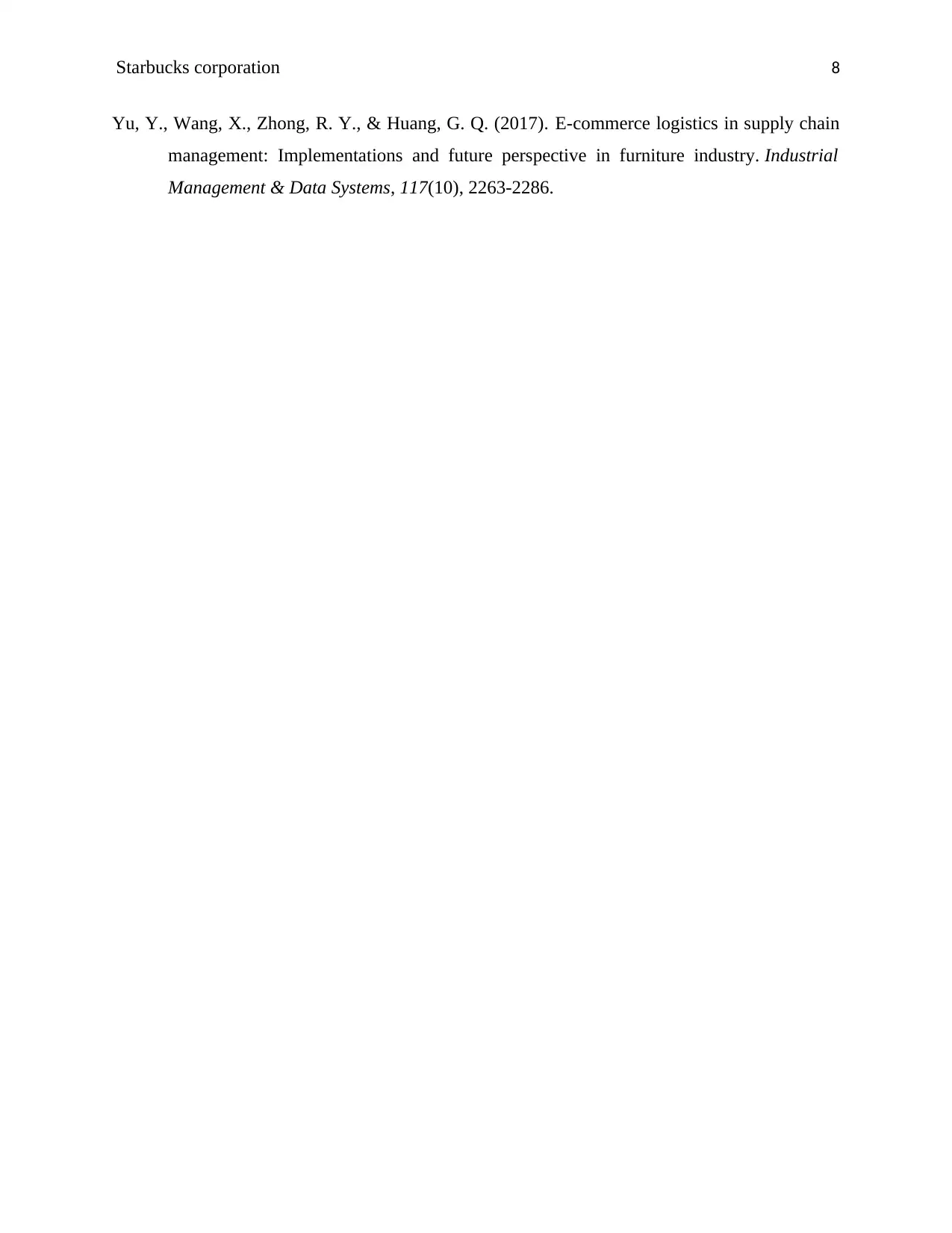
Starbucks corporation 8
Yu, Y., Wang, X., Zhong, R. Y., & Huang, G. Q. (2017). E-commerce logistics in supply chain
management: Implementations and future perspective in furniture industry. Industrial
Management & Data Systems, 117(10), 2263-2286.
Yu, Y., Wang, X., Zhong, R. Y., & Huang, G. Q. (2017). E-commerce logistics in supply chain
management: Implementations and future perspective in furniture industry. Industrial
Management & Data Systems, 117(10), 2263-2286.
1 out of 8
Related Documents
Your All-in-One AI-Powered Toolkit for Academic Success.
+13062052269
info@desklib.com
Available 24*7 on WhatsApp / Email
![[object Object]](/_next/static/media/star-bottom.7253800d.svg)
Unlock your academic potential
Copyright © 2020–2025 A2Z Services. All Rights Reserved. Developed and managed by ZUCOL.




